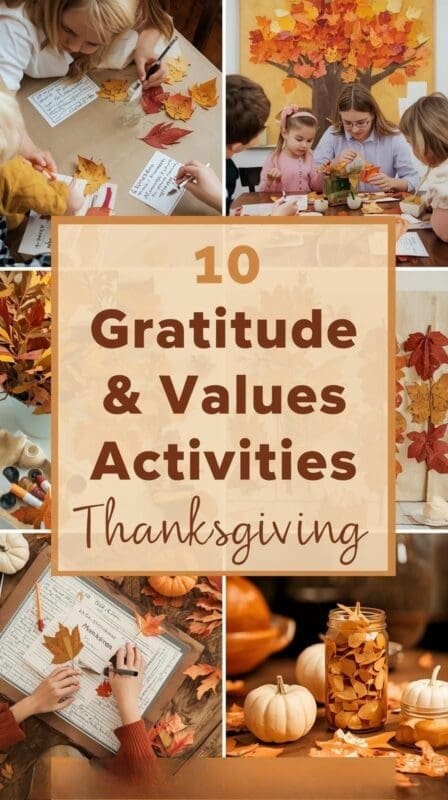The week before Thanksgiving, the classroom always feels different—a mix of cinnamon air freshener, rustling paper leaves, and children buzzing about favorite pies. They talk over each other about cousins visiting, grandma’s rolls, who gets to mash the potatoes. Underneath the chatter, there’s a softer invitation: to slow down and notice what matters. Over the years, I’ve learned that when kids combine creativity with reflection, gratitude becomes more than manners—it becomes a way of seeing.
These Thanksgiving SEL crafts are my favorite kind of pause. They turn paper, glue, and imagination into small rituals of empathy and connection. A bare paper tree fills with thankful leaves. A circle grows quiet as a pumpkin passes from hand to hand. A child writes, “I’m grateful for warm socks,” and suddenly the room exhales. This is how values take root—gently, through shared moments that feel true.
Why Gratitude & Values Belong Together
Gratitude and values are like roots and branches—one grounds us, the other helps us grow. Gratitude builds awareness first. When children pause to name what they already have—a friend who saved them a seat, a cozy blanket, a family meal—the nervous system softens. Attention shifts from scarcity to sufficiency, which widens empathy for others.
Values give direction. They guide children toward the kind of person they want to be, not just what they want to receive. Words like kindness, honesty, responsibility, and respect stop sounding like rules and begin feeling like choices that create safety and belonging.
Together they build connection. When gratitude meets values, appreciation turns active. “I’m thankful for my friend” becomes “I can be that kind of friend.” Kids learn that thankfulness isn’t passive; it’s something we practice with hands, voices, and daily habits—on holidays and every ordinary Tuesday.
A gentle transition
Once the room is primed with purpose, I like to let color lead the way. Big, visual projects help kids see gratitude growing in real time—then we bring those ideas inward with journals and sharing circles.
Gratitude Tree Craft
Watching a Gratitude Tree fill up is pure joy. The first day, a brown paper trunk looks a little lonely on the wall. By midweek, the branches overflow with leaves—scarlet, amber, gold—each carrying handwriting that ranges from careful print to squeezed-in scrawls. Some children write “my family,” others name the tiny, perfect things: “the class hamster,” “my fuzzy socks,” “the sun on the bus window.”
As new leaves go up, the room changes. Children stop to read each other’s notes, smiling at the overlaps. Gratitude turns into a shared landscape you can walk past, point to, and feel.
SEL reflection: Community-building through visible appreciation. Seeing many sources of gratitude normalizes joy and reduces comparison.
Value focus: Connection, belonging, respect for others’ stories.
Thankful Heart Wreath
There’s something tender about writing on heart-shaped paper. Kids pause before they begin, deciding who belongs there: “my brother,” “my teacher,” “hot cocoa.” We string the hearts into a circle—colors repeating like a warm pattern—and soon the wreath looks like love made visible.
One year, a child added “the custodian who jokes with me.” It was real and specific, and it made everyone look for kindness in new places. The wreath hangs by the door, catching the light, reminding us that gratitude often shows up in everyday helpers.
SEL reflection: Turning feelings into tangible symbols strengthens emotional awareness and recall.
Value focus: Kindness, appreciation, reciprocity.
A soft bridge
Once color covers the walls, it helps to bring meaning into play. When gratitude meets imagination, values become active, not abstract.
Family Values Feast
HThis is the activity that gets the most laughter—and the most real conversation. We design a “menu” for a thankful family: honesty as the main dish, kindness as a side, patience as the warm bread we pass around. Someone always suggests “gratitude pie” for dessert, and we decide if it’s best topped with whipped cream or extra thank-yous.
Children discover that values can nourish a family the way food does. They practice naming what keeps a table safe: listening, apologies, sharing. Then the menus go on display as quiet promises.
SEL reflection: Values identification through metaphor helps kids remember and apply them in daily routines.
Value focus: Teamwork, honesty, respect.
Gratitude Journals
When children sew or staple their own journals, gratitude becomes a habit their hands helped to make. We add leafy doodles, warm colors, maybe a strip of ribbon on the spine. Then we practice short entries at predictable times—after recess, during quiet time, before dismissal.
At first, entries are simple. Over days, the handwriting widens into detail: “I’m thankful for the way my friend waited for me when I tied my shoe.” Journaling settles a busy room; the scratch of pencils becomes its own kind of calm.
SEL reflection: Repeated, low-pressure writing builds mindfulness, self-awareness, and emotional vocabulary.
Value focus: Reflection, responsibility for one’s inner world.
Another gentle turn
After inward practices, I like to return to the circle—where gratitude becomes shared language and kindness can be witnessed out loud.
Kindness Pumpkin
A small pumpkin sits in the center like a friendly anchor. We pass it around the circle; each child names a kind action someone else did that week. I write the actions on slips of paper and tuck them inside or around the pumpkin: “helped me zip my coat,” “shared markers,” “asked if I was okay.”
Voices soften as the pumpkin passes. Smiles widen. The circle becomes a litany of noticing, a way to practice seeing goodness and saying it out loud. By week’s end, the pumpkin is ringed with paper notes like a halo.
SEL reflection: Reinforces prosocial behavior through recognition, not reward. Hearing kindness stories expands empathy and belonging.
Value focus: Compassion, gratitude-in-action.
Gratitude Circle Reflection
We close the day here whenever we can. The room dims a little, and each child shares one gratitude that money can’t buy: “my grandma’s hugs,” “someone reading with me,” “seeing the sky turn pink.” You can feel the exhale travel around the circle—body by body—until the group is quieter than it has been all day.
For children who need scaffolding, we use prompts: “A person who makes my life better is…,” “A way I can show kindness this week….” When a child struggles, peers offer gentle ideas. The circle becomes part ritual, part mirror.
SEL reflection: Practicing spoken gratitude builds confidence, listening skills, and vulnerability tolerance.
Value focus: Empathy, courage, respect for voices.
Putting It Together: A Thanksgiving Week Flow
Day 1–2: Fill the room with color. Start the Gratitude Tree and Thankful Heart Wreath. Let children add to both across several days so the visuals feel alive and evolving.
Day 3: Play with metaphor. Create Family Values Feast menus and display them as you talk about the “ingredients” that make your classroom or home feel safe.
Day 4: Go inward. Assemble Gratitude Journals and model short entries after a transition. Keep the tone light and specific.
Day 5: Share and integrate. Pass the Kindness Pumpkin and end with a Gratitude Circle Reflection. Invite children to choose one value to carry into the weekend.
This rhythm keeps energy balanced—big, collaborative art; playful conversation; quiet writing; gentle community sharing. It also mirrors how gratitude deepens: we see it, name it, write it, speak it.
Counselor Notes: Support for Diverse Needs
- Sensory seekers: Offer textured leaves (felt, corrugated paper) and soft seating for the circle.
- Emergent writers: Use stickers, picture symbols, or dictation for journals and trees.
- Shy speakers: Allow passing in the circle, or invite them to whisper their gratitude for you to share.
- Neurodivergent learners: Provide visual schedules, clear prompts, and predictable turn-taking; consider headphones during loud transitions.
Gentle Materials Guide
Keep supplies simple and soothing: autumn-tone craft paper, child-safe scissors, glue sticks, thin-tip markers, a small pumpkin, and LED tea lights for warm displays. If you’re building a class kit, add child-sized staplers for journals and a small basket for gratitude notes—tools that make the rituals feel special without overwhelming the senses.
A Heartfelt Closing
Thanksgiving may come once a year, but gratitude and values deserve daily attention. When children trace leaves, thread paper hearts, pass a pumpkin, or share a sentence that matters, they’re learning more than art skills. They’re practicing how to see goodness—in themselves, in one another, in the ordinary texture of a school day.
These small creative rituals linger. The paper leaves will come down; the journals will get tucked into backpacks. But the feeling stays: a steady, quiet gratitude that makes winter warmer and the work of growing up a little more gentle. That is the gift we can offer our students and our families—values with roots, gratitude with branches, and a canopy of belonging big enough for everyone.

About the Author
Hi, I’m Eve, a former school counselor with a master’s degree in School Psychology and a passionate advocate for children and families navigating sensory challenges. As a mom of children with sensory sensitivities, I deeply understand the journey special-needs parents face, and I dedicate myself to researching and sharing practical solutions to help children thrive and feel comfortable in their bodies. My goal is also to empower counselors, therapists, and psychologists with creative strategies and supportive resources to enrich their everyday practice. When I’m not writing or exploring new therapeutic approaches, you’ll find me spending quality time with my family and continually seeking inspiration from everyday moments.




